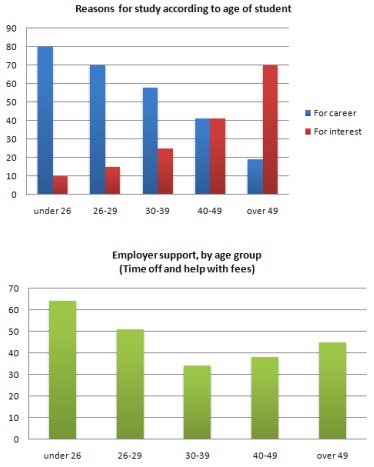The charts below show the main reasons for study among students of different age groups and the amount of support they received from employers.
Summarise the information by selecting and reporting the main features, and make comparisons where relevant
First of all, the first graph indicates why people continue their study and the second bar chart gives percentage of study grant. There are two reasons for studying and five age groups which have an opportunity to study with employer support.
Overall, the first graph illustrates that the percentage of career reason with age is a dramatic fall, while several old people take interest reason for studying. Meanwhile, young people have the highest percentage for receiving study grant.
According to the data, the percentage of three age groups (under 26, 26-29 and 30-39) which have reason for a great job, decline slowly from 80% to under 60%. However, the second reason, fascinate, grows a steady increase nearly 10% for young people, 15% for 26-29 age group and 35% for 30-39yr. Moreover, older people prefer to be expert for establishing a business (nearly 70%) than look for career (under 20 percent).
Interestingly, 40-49 age group has equal number of people who have purpose for interest and career.
A more detailed look at the bar chart reveals that for the under 26 year students have the maximum employer grant with approximately 60%. 26-29 and 30-39 age groups come to second and third percentage which have more over 50 percent and 35 percent, while 2 age groups (40-49 and over 49) rise dramatically and achieve from under 40% to 45%.
Clearly, employer support is provided for career-focused study and the highest percentage of student, who has career purpose, has doubled amount that than 30-39yr.
Summarise the information by selecting and reporting the main features, and make comparisons where relevant
First of all, the first graph indicates why people continue their study and the second bar chart gives percentage of study grant. There are two reasons for studying and five age groups which have an opportunity to study with employer support.
Overall, the first graph illustrates that the percentage of career reason with age is a dramatic fall, while several old people take interest reason for studying. Meanwhile, young people have the highest percentage for receiving study grant.
According to the data, the percentage of three age groups (under 26, 26-29 and 30-39) which have reason for a great job, decline slowly from 80% to under 60%. However, the second reason, fascinate, grows a steady increase nearly 10% for young people, 15% for 26-29 age group and 35% for 30-39yr. Moreover, older people prefer to be expert for establishing a business (nearly 70%) than look for career (under 20 percent).
Interestingly, 40-49 age group has equal number of people who have purpose for interest and career.
A more detailed look at the bar chart reveals that for the under 26 year students have the maximum employer grant with approximately 60%. 26-29 and 30-39 age groups come to second and third percentage which have more over 50 percent and 35 percent, while 2 age groups (40-49 and over 49) rise dramatically and achieve from under 40% to 45%.
Clearly, employer support is provided for career-focused study and the highest percentage of student, who has career purpose, has doubled amount that than 30-39yr.

